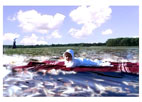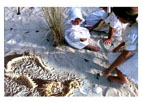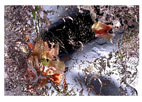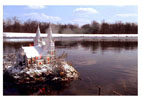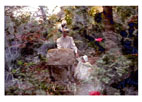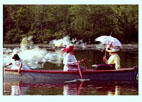Three Films (Summer Light, Babobilicons, and Divine Miracle)
- Daina Krumins |
- 2005 |
- 38 minutes |
- COLOR |
- SOUND
Summer Light
My way of seeing the world, or of re-assembling it in my mind, is unconventional. My main preoccupation as an artist, and to some extent as a person, has always been based on texture. Texture is such a small consideration for most people, to say that my visual world-view is based on a relationship with textures is almost like saying that the most important thing about a piece of writing is the number of punctuation marks. It seems silly.
And yet, I believe it as a valid a way of looking at the world as any other way. But I wonder why repetitions have so much meaning for me. One possibility that has occurred to me is that perhaps my mind is more primitive in some ways, and that my obsessions and fixations have something to do with evolution. How to explain? OK. If a bird flies between two blueberry bushes and one bush has lots of berries and one has only a few berries, how does it know where to go? The same with a monkey looking at banana trees, or perhaps even a billionaire considering his various bank accounts.
"Summer Light" come from my texture-driven, non-neurotypical way of finding delight and meaning. It's not verbal meaning, All I say in words is that it does, in fact, have meaning. In a way, it is my world. Daina Krumins
It won the Silver Award (second place) at the Big Muddy Film Festival. Shown at the Athens Film Festival, Dallas Video Festival and Not Still Art.
2001, color/so, 17m
Babobilicons
"Daina Krumins's 1982 BABOBILICONS is a spectacular special-effects study of molds, mushrooms and similar vegetation." - Richard Shephard, The New York Times
"Daina Krumins's BABOBILICONS is a truly surrealist work in terms of both its process and product. Krumins takes time to make her films. It took her nine years to create this remarkable animated short, yet her method is in line with the surrealist affinity for chance operation. She cultivated slime molds on Quaker five-minute oats in her basement, planted hundreds of phallic stink-horn mushrooms, and put her mother behind the camera to film them growing. The results are sexual and bizarre. She combined ordinary objects - wall sockets, candles, and peeling paint - to get unnerving, dreamlike images. Porcelain fish jump through waves; mushroom erections rise and fall. Her Babobilicons - robotlike characters that resemble coffee pots with lobster claws - move through all this with mysterious determination. Anyone who orders 10,000 ladybugs from a pest control company to film them crawling over a model drawing room definitely possesses a sense of the surreal." - Renee Shafransky, The Village Voice
Awards: Bronze Hugo, Chicago Int'l Film Festival; Sinking Creek Film & Video Festival; Atlanta Independent Film Festival; SF Art Institute Film Festival.
1982, 16mm, color/so, 16m
The Divine Miracle
Christ: John Taylor; Angels: Scott Martin; Sound: Rhys Chatham; Camera: Alan Grabelsky and Jose Sedano.
"An intriguing composite of what looks like animation and pageant-like live action is THE DIVINE MIRACLE, which treads a delicate line between reverence and spoof as it briefly portrays the agony, death and ascension of Christ in the vividly colored and heavily outlined style of Catholic devotional postcards, while tiny angels (consisting only of heads and wings) circle like slow mosquitoes about the central figure. Ms. Krumins tells me that no animation is involved, that the entire action was filmed in a studio, and that Christ, the angels and the background were combined in the printing. She also says it took her two years to produce it." - Edgar Daniels, Filmmakers' Newsletter
Awards: First Place, Ann Arbor Film Festival, 1973; Best Short Film, Bellevue Film Festival; Silver Hugo, Chicago Int'l Film Festival.
1973, 16mm, color/so, 5.5m



